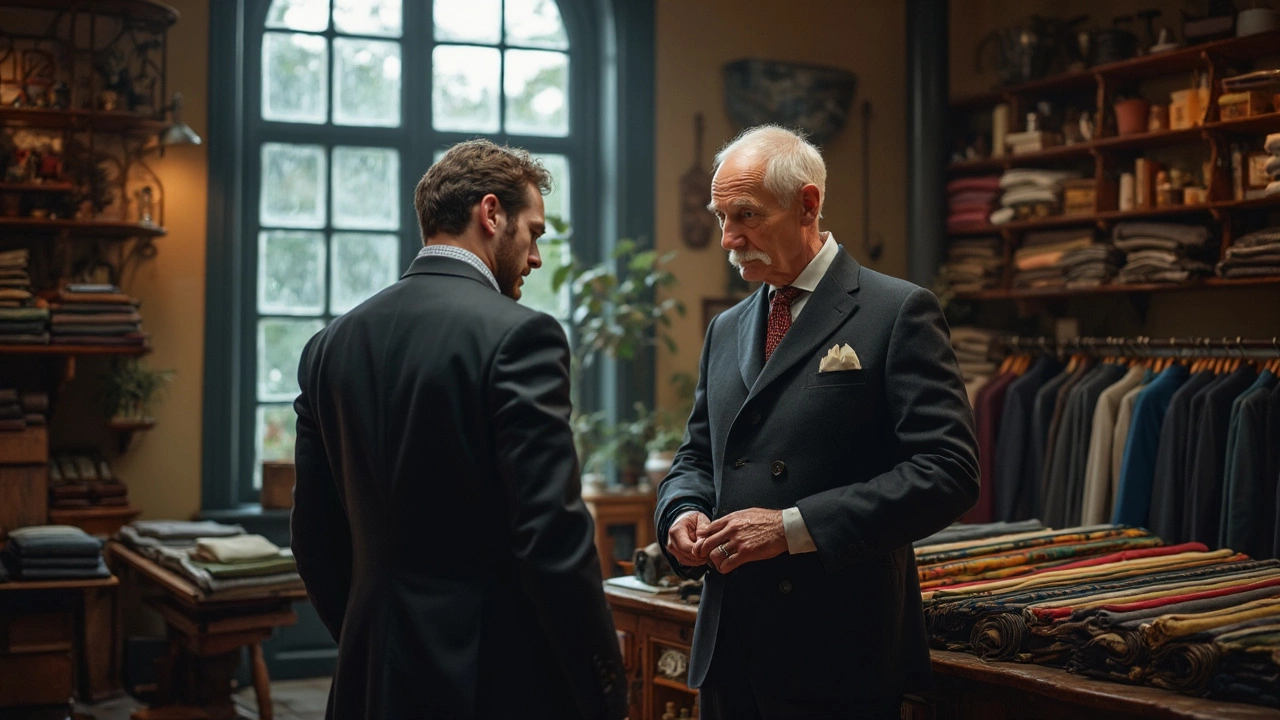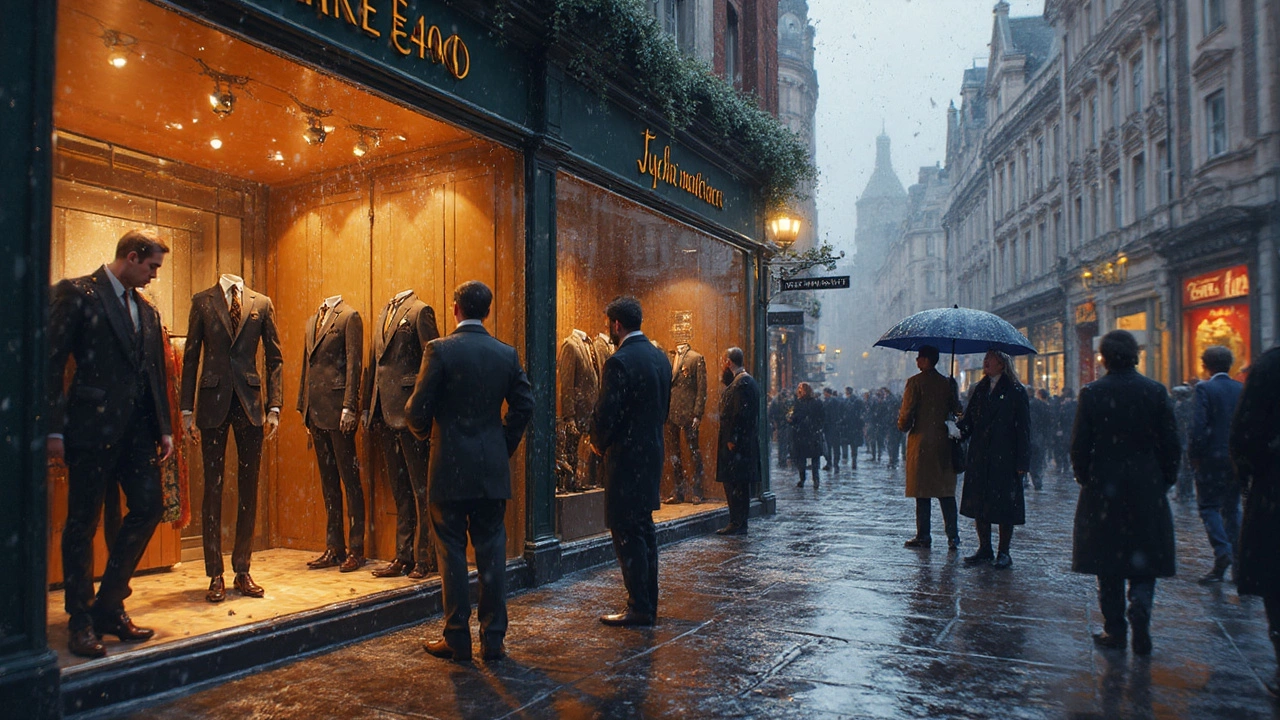Walk down Dublin’s Dawson Street and you’ll see suits priced everywhere from €400 to well over €4000. So, is a more expensive suit just about showing off, or is there actually a huge difference? In Ireland, where both unpredictable weather and a sharp business scene play a part, the answer isn’t as clear as you might think.
Start with the basics: for €500 off-the-rack at somewhere like Brown Thomas, you’ll get machine-stitched seams and blended wool. It’ll cover you for job interviews and weddings—but might not hold up to frequent rain or travel between Galway and Cork. Step up to a €5000 suit, and now you’re looking at pure Italian or British wool, often hand-sewn, custom-fit from someone like Louis Copeland & Sons or bespoke studios in Belfast or Limerick. Every detail is tweaked for the Irish body shape, posture, and, yes, even the kind of weather we drag our suits through.
- What Goes Into the Price Tag?
- The Irish Suit Shopping Experience
- Everyday Wear and Special Occasions
- Smart Buying Tips in Ireland
What Goes Into the Price Tag?
If you’re comparing suits on the Irish high street, brace yourself—the difference isn’t just the number on the price tag. It comes down to quality, effort, origin, and brand reputation. Let’s break down the basic costs you’re really paying for.
Fabric is the big one. Cheaper suits often use wool mixes, sometimes blended with synthetic fibres. If you buy a €500 suit from a department store in Galway, there’s a good chance it’s made from standard wool-polyester blend. Step up to high-end shops in Dublin or Cork, and you’ll find pure merino, worsted wool, maybe even cashmere. These fancy fabrics breathe better, drape better, and usually last much longer—especially in the Irish climate.
The next step up is construction. A €500 suit is usually fused (glued) at the seams; it makes them quicker and cheaper to produce but less durable. By the time you’re spending over €3000 on a suit, you’re looking at full canvas construction. This means there’s a layer inside made from horsehair or similar, stitched by hand—so, the jacket shapes to your body over time and doesn’t get wobbly in our damp winters.
The fit isn’t just vanity. Most department store suits come in standard sizes—close enough, but rarely spot on. Higher budgets open up options for made-to-measure or full bespoke, with Irish tailors measuring you in detail and sometimes having multiple fittings. This is where brands like Louis Copeland & Sons or Magee of Donegal shine, using local skills to create something that feels just right, even if you cycle to work or play a bit of five-a-side after the office.
Let’s talk numbers. Here’s a look at what usually sets these suits apart on the Irish market:
| Feature | €500 Suit (Off-the-Rack) | €5000 Suit (Bespoke) |
|---|---|---|
| Fabric Quality | Wool blend, mostly imported | Pure Italian or British wool, sometimes Irish tweed |
| Construction | Machine-stitched, fused lining | Hand-stitched, full canvas |
| Fit Options | Limited sizes | Completely custom, multiple fittings |
| Durability | 2-4 years (with heavy use) | 10+ years (with proper care) |
| Made In | Often Asia/Eastern Europe | Ireland, UK, or Italy |
One last thing: branding. Sometimes you’re paying a premium just for the name. But in Ireland, especially in smaller cities like Limerick or Sligo, shoppers are pretty canny—the name only matters if it really means better craftsmanship or better materials. So next time you see two sharply dressed fellas at a wedding in Kilkenny? Chances are, there’s more between their suits than meets the eye, and you can usually spot it if you know what to look for in Ireland.
The Irish Suit Shopping Experience
Shopping for suits in Ireland can feel a bit like a rite of passage, especially if you’re picking out your first work suit or gearing up for a wedding in the west. The strong tradition of tailoring here means you’ll find everything from big department stores to family-run ateliers. Dublin is the epicentre for choice, but cities like Cork, Galway, and even Waterford have their own strong offerings.
Walk into Brown Thomas or a department store on Grafton Street, and you’re looking at a range of prices, styles, and off-the-rack cuts. These shops offer decent value for everyday professionals, especially if you’re after popular Irish brands like Magee 1866 or Remus Uomo. But what’s really interesting is how Irish men are shifting from quantity to quality—a recent report from the Irish Independent showed Irish buyers investing 30% more in formalwear after 2021, mainly because a sharp suit just lasts longer and fits better if you spend a little extra.
If you’re serious about making an impression at a business event in Dublin or a wedding in Killarney, bespoke is a different world. A trip to Louis Copeland & Sons is a lesson in how tailoring should feel: the measuring is precise, the fabric selection takes ages, and you’ll get honest feedback about what flatters your build (something you just don’t get from most chains). Here’s what Louis Copeland himself says about Irish shoppers:
“Irish clients ask loads of questions and want real value, not just a name stitched inside the jacket. Comfort, how it drapes, and whether it can stand up to Dublin drizzle—these matter just as much as the style.”
There are some distinct features you’ll spot locally:
- Irish suits almost always use heavier wools for warmth and durability, thanks to the damp, windy climate.
- Water-repellent finishes or tightly woven cloths are popular in places like Galway where it never stops raining.
- Shorter trousers and slimmer cuts match what you see in the city, but out west, a looser fit is often preferred (think comfort first for rural events).
If you’re still stuck deciding, check how the details change with price. More expensive suits usually have features like hand-stitched buttonholes, real horn buttons, and a lining that feels cool and breathable on those stuffy Luas tram rides. Here’s a quick comparison for shoppers in the Ireland market:
| Feature | €500 Suit | €5000 Suit |
|---|---|---|
| Origin | Mass-produced, usually overseas | Bespoke, often made locally (Dublin/Belfast) |
| Material | Wool blends, synthetic lining | 100% Irish/Italian/British wool, silk lining |
| Fitting | Standard sizing, minor adjustments | Custom-tailored, multiple fittings |
| Durability | 3-5 years average | 10+ years with care |
It’s not always about spending the most—it’s knowing what fits your style, your work life, and how often you’ll wear it. That’s the real Irish suit shopping experience in a nutshell.

Everyday Wear and Special Occasions
Let’s be honest, a lot of suits in Ireland never see the inside of an office—they’re saved for weddings, communions, graduations, and maybe the odd Court appearance (hopefully just jury duty). So, how do $500 and $5000 suits hold up in daily Irish life versus those big events?
For everyday workwear, a €500 suit usually does the job fine, especially if you’re running around in Dublin’s docklands or jumping from train to Luas. These suits tend to use mixed fabrics, which makes them easier to clean. If you’re facing typical Irish rain and wind, a cheaper suit might show wear faster—look out for bubbling fabric around the seams or sagging shoulders after a few rides on the DART. On the upside, you won’t panic if you spill a sausage roll on it at a lunchtime market.
Move to weddings, black-tie events, or gala nights at something fancy like the Mansion House, and suddenly the differences truly matter. A €5000 suit shines at these moments. The fit is sharper because it’s literally tailored to you, and the fabrics—think pure Donegal tweed or superfine Italian wool—hold their shape all night. Ever noticed those grooms in photos who look like their jackets are swallowing them by the end of the night? That doesn’t happen with a bespoke suit.
Want to keep a pricey suit looking great? Here are some quick care tips you’ll actually use:
- Always hang it on a wide-shouldered hanger (not a wire one from the dry cleaner—please).
- Let it air out overnight after wear, especially if you got caught in the rain running from Wexford Street to a taxi.
- Steam out creases instead of ironing to avoid shiny patches.
- Don’t overload the pockets with wallets or keys—lumpy jackets are never in style.
Most Irish folks rotate between a budget suit for daily use and keep one higher-end option for important occasions. It isn’t about having a wardrobe crammed full of options—it’s about knowing when to wear each. Whether you’re attending a wedding in a castle in Meath or a work pitch in Cork, matching the suit to the day (and the weather) just makes sense.
If you want to really stand out at an event, local brands like Magee 1866 offer limited edition Irish tweed suits that make a statement without shouting about it. That’s one tradition in the Ireland suit scene—a bit of quiet confidence always trumps flashiness.
Smart Buying Tips in Ireland
Finding a suit that fits your life in Ireland isn’t just about the price tag. Let’s talk practical tactics for getting good value—whether you’re buying in Cork, Galway, or splurging on Grafton Street in Dublin. Here are smart, real-world tips you can actually use here at home.
- Ireland isn’t famous for sunshine, so pick suits made from water-resistant wool or wool blends. Pure wool is often worth the splurge for breathability and durability, especially if you’re wearing your suit often in the wet climate.
- Check where the suit is made—Irish brands like Magee 1866 offer locally woven Donegal tweed, which stands up well to Irish weather. You’re supporting local jobs and getting something built for harsh conditions.
- If you’re not built like a mannequin (who is?), always budget for alterations. Dublin’s tailoring scene is full of pros—Altering your €500 suit for €60 can make it look twice the price.
- Watch out for seasonal sales. Big Irish shops like Brown Thomas, Arnotts, and Louis Copeland often do major end-of-season discounts, especially just after Christmas or summer weddings.
- For busy guys, travelling tailors like Suit Republic or online brands with Irish fitting rooms (Moss Bros now ship here) can help you squeeze a fitting into your workflow without trekking across the country.
Here's a quick table on what Irish shoppers usually get for their money in 2025—pricing is in euro to keep it real.
| Price Range | Main Materials | Best For | Where to Shop |
|---|---|---|---|
| €400-€700 | Wool blend, polyester | Work, interviews, occasional events | Arnotts, Brown Thomas, Next |
| €800-€1500 | 100% wool, some Irish tweed | Regular business wear, formal events | Magee 1866, Louis Copeland, Remus Uomo |
| €2000+ | Bespoke, hand-tailored, luxury wool | Weddings, career milestones, special occasions | Private tailors, luxury boutiques, Savile Row (Dublin pop-ups) |
Don’t forget, Irish customer service tends to be friendly. Never feel shy asking for advice or bringing in your own shoes to a fitting—tailors here expect it. Last tip: if you’re buying a suit for a big event, order at least eight weeks ahead. Irish weddings and corporate events tend to peak in spring and fall, so tailors get swamped fast.
